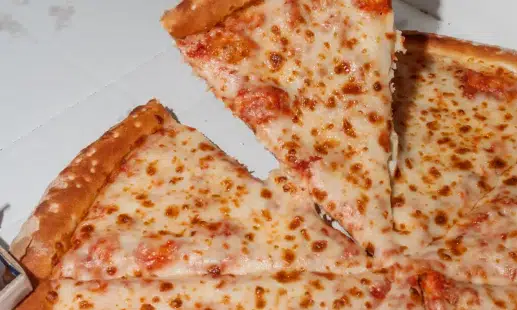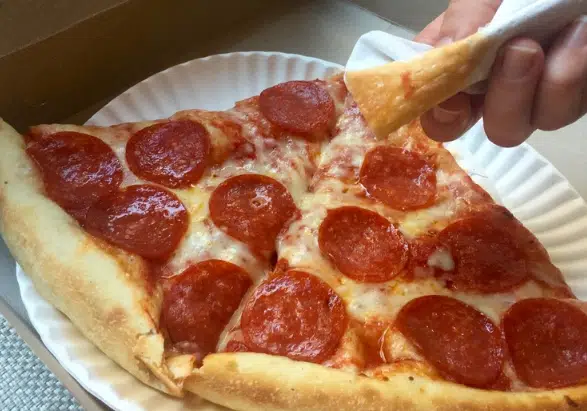Pizza is a popular food. Although Pizza is loved by many, very few people understand how it’s made and what Makes Pizza Greasy. On this page are some simple tips on making Pizza less greasy.
There are two ways that a slice of Pizza can be greasy. The first way is through the cooking process, and the second way is from the toppings themselves.
The fats in cheese, the oils in meats, and the heavy dough contribute greatly to greasiness. On top of that, oily toppings such as pepperoni or sausage are also part of what makes a pizza greasy.
However, Pizza is considered one of the greasier foods because so many ingredients are added as toppings. Tomatoes, cheese, and meat contain fat or oil that has not been baked off the Pizza properly, which is tasty and gives desirable foods.
Though, eating too much-saturated fat causes an increase in bad cholesterol levels, blocking arteries and increasing the risk for heart attacks.
What Makes a Pizza Greasy?
 A greasy pizza essentially has 2 components: the external layer is the crust and edges of the Pizza doused in hot cheese, and the inner layer is the melted cheese between the toppings. The following are what makes Pizza greasy:
A greasy pizza essentially has 2 components: the external layer is the crust and edges of the Pizza doused in hot cheese, and the inner layer is the melted cheese between the toppings. The following are what makes Pizza greasy:
Bad Cheese
In a slice or order pizza, the cheese is constantly dripping off the edge of the slices, or strings of gooey cheese stretch across the plate.
Cheese has the most fat-soluble flavor oils, but oil doesn’t usually drain out of the cheese when you melt it.
Fat is less dense than water, but cheese has tiny air bubbles. When you put cheese into hot liquid or melted fat, the fat-soluble flavor oils that are soluble dissolve into the fat and fill up all those tiny bubbles. The cheese turns into the consistency of pudding. That’s why your Pizza gets too greasy most time.
Additionally, Cheeses with lower melting temperatures penetrate deeper into the dough and make a pizza greasier than those that don’t.
Excess Oil
the most common reason for greasy Pizza is that there is too much oil. Pizza baked in excess oil will have a layer of grease on the bottom and the top of the pie.
The sauce is cooked first in the pizza preparation process and receives the most oil. Then cheese goes on top of that with an additional splash of its own, making the oil increase.
However, excessive oil on a pizza comes from Cheese and Toppings. Order a pizza with “light” or “low-fat” cheese whenever possible. It will help keep the Pizza from being greasy.
The Crust thickness
The major players in grease dripping are crust thickness. A thick crust will always produce more grease than a thin one.
A super-thick doughy crust can hold extra grease and be soft inside, while a thin pizza has less oil and more crunchy crust.
However, The secret to a crispy pizza crust lies in the thickness. If it’s too thick, it will be hard and crunchy. If it’s too thin, it will be soggy and floppy. An ideal crust is light and flaky, with just the right balance of crispy, chewy, and airy.
Wet Dough
Wet dough is the main culprit when it comes to greasy Pizza. When you make homemade pizza dough, you have to knead it by hand, and that can cause the dough to become very moist (sticky), making it harder for the dough to stretch and hold its shape.
Also, wet ingredients such as tomato sauce and cheese prevent the water from evaporating effectively. It leads to slower evaporation of the water, which means that the dough will be kept for some time at a high temperature. It can make the pizza dough greasy.
Note: When the pizza dough is left to sit for too long, the flour absorbs all the moisture in the air. The less water in the dough, the more oily and greasy it becomes when cooked.
Improper Dough Kneading
Dough that is not kneaded correctly will have a finished product that is more greasy than the result of dough that has been kneaded correctly. When this is avoided, the Pizza will have a better taste and crust that is not greasy.
Also, too-greasy Pizza happens when the dough is kneaded and stretched while too wet.
When you squeeze the dough in your hand or press it flat, it will compact the yeast and remove air pockets essential for good texture and rising.
keeping the dough for longer after adding toppings
If you want to make the ultimate, extra greasy Pizza, then you need to avoid one thing: keeping the dough for longer than about 5 minutes after adding toppings. Also, leaving the dough in the pan for too long after pouring the sauce leads to the greasiness of the Pizza.
Moreso, these toppings are applied warmly, causing them to melt and ooze their way into the layers of dough. If you keep this Pizza in a warm oven for too long, you end up with an overly greasy mess.
The baking method used
A pizza baked in a regular oven, for example, will allow the cheese and toppings to fall into the bottom of the Pizza, causing it to be greasier.
For example, if you look at a pan pizza, it will always seem greasier than a thin crust because the toppings and cheese have settled into that Pizza’s bottom. By having water bake your Pizza or having a gas flame under your Pizza, you get a nice crispy crust, and the toppings stay on top of the Pizza without going into the crust.
Although, the method that produces a greasier pizza crust is first to use oil in a pan to bake the pizza crust. It is followed by adding the sauce and finally topping with cheese. The extra oil absorbed by the dough causes a more greasy pizza crust.
However, some pizzas have a smooth and slightly oily coating that can easily be wiped up with napkins; others have an extremely oily, glistening appearance.
How to Make Pizza Less Greasy
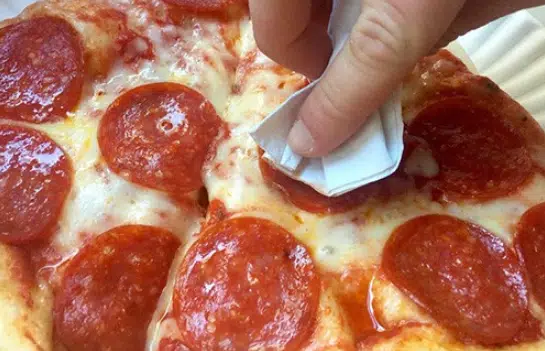
Use low moisture cheese
Low moisture cheese is less greasy than regular mozzarella, so it’ll keep your Pizza from becoming a grease-soaked napkin.
With low moisture cheese, since it is full of fat and protein, you will be able to make a great-looking pizza without having that greasy look.
Moreso, low moisture cheese is moister than many other grating slices of cheese but still harder than part-skimmed and non-fat cheeses. If the pizza chef uses this cheese, he will have less grease on his dough.
Moisture and fat go hand-in-hand, so low moisture cheese will absorb less grease from the rest of the ingredients. You can save nothing less than 50 calories and 6 grams of fat while only losing a few milligrams of protein.
Thicker Crust
Thicker crust tends to be crispier and less greasy since there’s a larger air space between the top of the Pizza and its oils. The extra layer of thickness will give your Pizza less grease.
You can put a cooling rack on top of your Pizza and then flip it over once the crust becomes firm. This way, all the oil will be drained from the crust to the bottom of the pan.
A thicker dough will take longer to cook, but less greasy Pizza will be greasy.
Use soft ingredients
Another way is to use soft ingredients such as tomatoes, mozzarella cheese, ricotta, and more. These ingredients are soft, so there is not as much grease as if you were to fill your Pizza with pepperoni, bacon, and sausage links.
It will help to reduce the amount of grease that escapes during cooking. Of course, reducing the amount of cheese and oil will also help keep your Pizza healthier.
Use Traditional Cheese
You can make Pizza less greasy by using traditional cheese instead of processed cheese. You may think that processed cheese is always better, but in the case of Pizza, it makes your Pizza greasier.
Traditional cheese, such as mozzarella, provolone, and cheddar, have less fat and are thus typically lighter/ The oils in low-fat mozzarella are better than processed cheese and won’t leach out much grease if you are concerned about making your Pizza less greasy.
Bake at High Temperature
If Pizza is baked at a high temperature and uses minimal oil on the dough, your Pizza will come out much less greasy.
At a high temperature, the oil in the dough will fry rather than soak into the cheese and toppings. A crispier crust means a lighter pizza.
However, the amount of oil absorbed by ad ough depends on the flour you use.
Use Pre Cooked Pepperoni
Use precooked pepperoni. Some pepperoni is a preservative, and oils are injected into the meat before dries. Precooked pepperoni has very little grease and just enough flavor to add a tasty touch of Italian flavor—half the calories, fat, and carbs as a regular slice of pepperoni.
However, there is a simple solution. The next time you make Pizza try using precooked pepperoni instead of raw pepperoni. You will get the same great taste of pepperoni but without all the greasiness.
Blot the Pizza
When the Pizza comes out of the oven, it is usually covered in thick grease that takes away from the flavor.
To prevent this, make sure to blot your Pizza with a paper towel before serving. It will absorb excess grease and make your Pizza look better while also giving it more flavor.
It means that you should take a clean cloth or paper towel and rub the top of the Pizza, concentrating on the crispier spots.
Serve on a Clean Surface
During assembly, the dough and toppings on your Pizza come in contact with the grease-laden countertop. This greasy residue will quickly seep into the crust, giving you some seriously greasy pizza.
To keep your pizza burners clean and your pizza crust crunchy, it’s best to transfer pizza assembly to a clean surface, such as a wooden cutting board or large aluminum baking sheet.
How Much Calories in Pizza
Calories in Pizza depend on the number of toppings. A slice of cheese pizza has about 180 calories.
One slice (3.5-inch diameter) of Meat Lovers Pizza from Pizza Hut – has 101 calories, 4g fat, and 12g protein.
However, non-stuffed chicken parm only has 293 calories per slice and is low fat.
Is Pizza Grease Bad for You?
Pizza grease is rancid for you because of all the preservatives, chemicals, and artificial flavors. Many of these harmful ingredients are in most fast food cheeses and pizza recipes. It can clog arteries, cause kidney failure, liver damage, and brain damage if eaten too often.
If you want to eat healthier and have more energy, try eating smaller portions of healthy greasy Pizza.
When we eat foods high in fat, it sticks to the inside of our digestive tracts and will take forever for our body to digest completely.
Typically, the body moves this along at a pretty regular pace, but it can become very dangerous when you consume more fat than it can handle. That’s why the easiest way to clog up your arteries is by consuming too much Pizza – especially if you don’t combine it with exercise.
More so, not all fats are bad for you. Some can be good. For example, monounsaturated fats and polyunsaturated fats help heart disease and lower cholesterol levels. But you don’t want to consume too much-saturated fat, which is found in red meat, high-fat dairy products such as cheese, whole-milk dairy products, and the skin on poultry.
How to Make Frozen Pizza Less Greasy
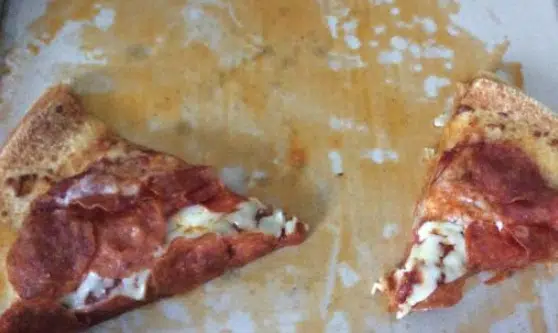
The best way to make your frozen Pizza less greasy is to put a paper towel between the Pizza and the foil. It will soak a lot of the grease. Also, try using a toaster oven. It usually dries out the crust and takes all of the greases away.
The second secret to making frozen Pizza less greasy is to cook it right before eating.
Another way to prevent this is to cover the Pizza before cooking it. Take aluminum foil, place it over the Pizza and then put another sheet on top. Press down (but not hard) with your hands or a second sheet/pan to speed up the process, and allow for space between your hands/pan and the top one so that heat can still get through. You’ll want to let it cook for about 5 minutes before uncovering it.
After it has finished cooking, you will be ready to use an easy-to-clean spatula to remove foil from the pizza pan.
What Makes Pizza Unhealthy?
Pizza might be unhealthy, but eating it every once in a while won’t kill you. To understand that Pizza is almost like a multivitamin – technically good for you, but bad if you overeat.
The thing that makes Pizza unhealthy is mostly the things on it. For instance, Pizza usually has a lot of cheese, and cheese is one of the main things to avoid when trying to lose weight or even eat healthier.
Though, Pizza is not necessarily unhealthy in itself. But if you overeat Pizza, you will put on weight.
Frequently Asked Questions
Why does my Pizza come out greasy?
Your Pizza might come out greasy if you fail to keep the following things in mind: – Use the correct type of pan. If you use a too big pan, there will be extra space around the edge of the Pizza. Extra space means less contact between the bottom of the Pizza and the pan. Without enough contact, moisture from the sauce may evaporate instead of being absorbed by the crust. It causes your Pizza to dry out and sometimes come out greasy.
What cheese makes Pizza greasy?
A few kinds of cheese contain higher fat content, but mozzarella is the most famous. Most pizza parlors use it to make the crust, and you mainly eat cheese. If you still want to enjoy Pizza without feeling guilty, use low-fat mozzarella cheese or even make your Pizza at home.
What is the grease on Pizza?
The “grease” on a slice of Pizza is a layer of cheese and tomato sauce that sits on top of the crust. Sometimes a crispy layer of oil on your Pizza is called a “bloom.”
Pizza can be considered greasy if you overeat it or order takeout and eat it immediately. For example, a large pepperoni pizza may have more calories than a salad with grilled chicken breast, tomato, and onion.
Conclusion
Different types of Pizza are greasier than others. If you like stuffed crusts and thick toppings, you will probably find that your Pizza ends up being a lot greasier than the next person’s. Ultimately, the quality of the ingredients you use and how you cook them play a significant role in how greasy your food will end up being. A little bit of grease isn’t bad for you, though you need to know what makes Pizza greasy so you can know how to avoid it.
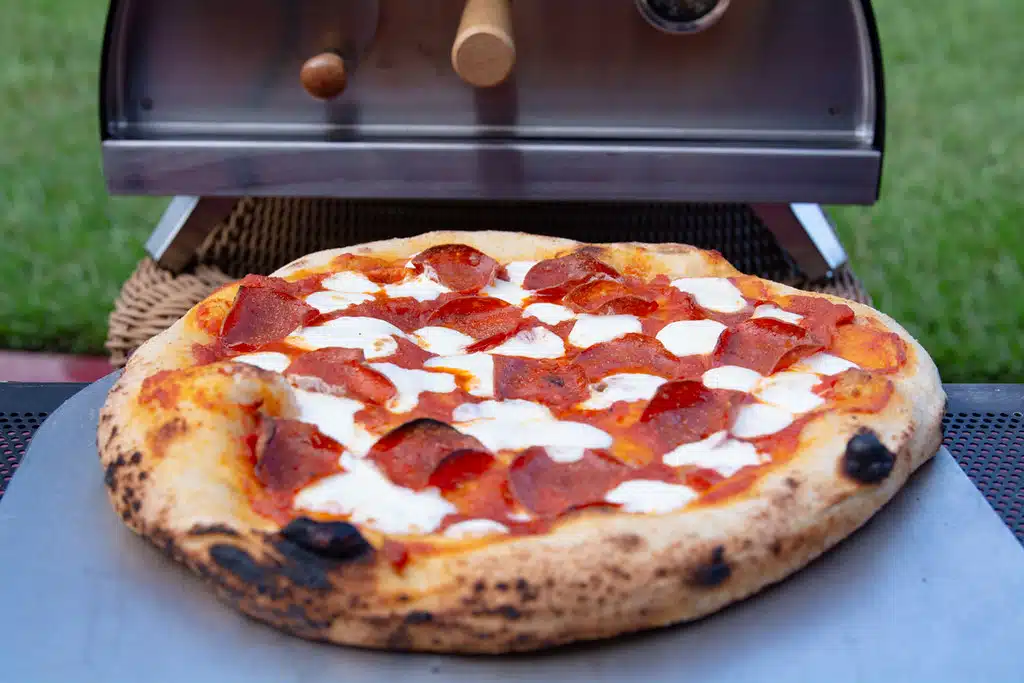
Equipment
- 1 Oven
Ingredients
- 330 g pizza dough
- 4 tbsp Classic Pizza Sauce
- 70 g mozzarella cheese
- 8 slices pepperoni sausage
- Pinch ground black pepper
Instructions
- Make the pizza dough in advance. Everything you need to know about producing the ideal classic pizza dough is included in this tutorial.
- We advise making our simple Classic Pizza Sauce as the pizza’s sauce. This is the perfect pizza sauce to help bring out the flavours of the other ingredients because it has a bit of garlic, salt, and basil.
- Start the Ooni pizza oven. On the stone baking board inside, aim for 932°F (500°C). Using the Ooni Infrared Thermometer, you can quickly and conveniently check the temperature inside your Ooni.
- Dust your Ooni pizza peel with a little flour. Lay the 12- or 16-inch-long pizza dough ball out on your pizza peel. Spread the sauce thinly and evenly across the pizza crust using a wide spoon or ladle. Add the mozzarella next, then the pepperoni.
- Make sure to spin the pizza frequently as you slide it off the peel and into your Ooni pizza oven.
- After cooking, take the pizza out of the oven. After adding the pepper, scatter some torn basil leaves over the pie. Serve immediately!

